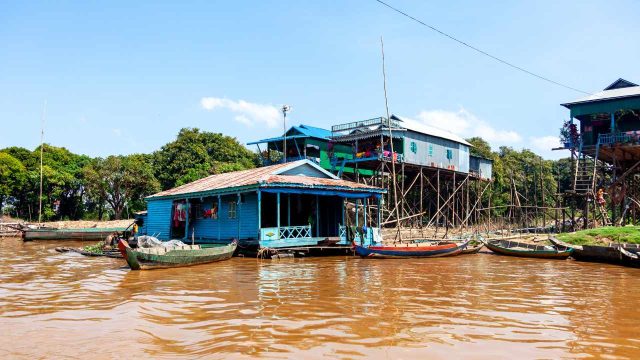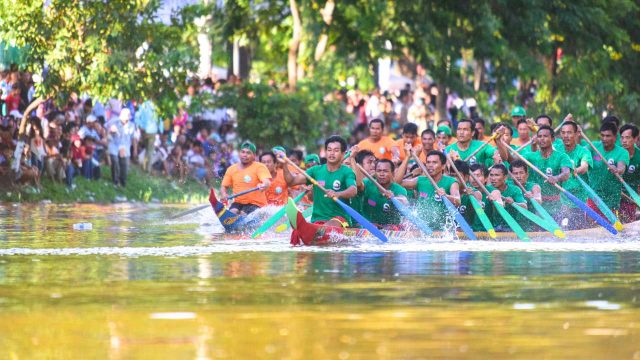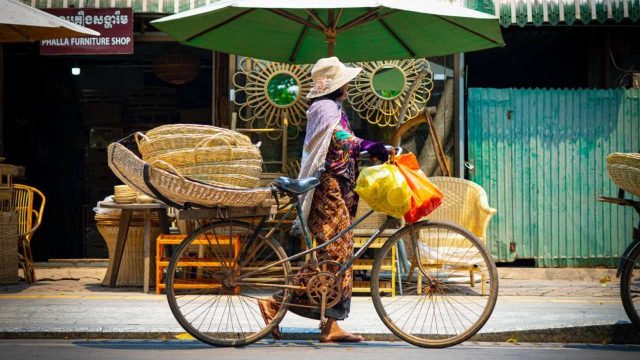Your travel dollars, and the ones of your fellow travelers, create jobs for 847 local families each year – here’s exactly how!
Your Tourist Dollars Create Real Change
Your Siem Reap visit directly supports Cambodian artisans and communities through purchases that create jobs for 847 local families each year. Every dollar you spend on authentic crafts puts money straight into artisan pockets. How your Siem Reap visit directly supports Cambodian artisans and communities shows up in three main ways: workshop employment, family income, and skill training programs. Tourist spending generates $794 million for the local economy. This creates work for over 20,000 people in the craft sector alone.
Why Your Travel Money Matters More Than You Think (And We’re Not Just Talking Souvenirs)
How your Siem Reap visit directly supports Cambodian artisans and communities starts the moment you step off the plane. Your trip creates a money chain that reaches deep into rural villages. Local families depend on this income to survive and grow.
The numbers tell a powerful story. Tourism brings in nearly $800 million to Siem Reap each year. This money doesn’t just stay in fancy hotels. It flows to silk weavers, stone carvers, and pottery makers across the region. How your Siem Reap visit directly supports Cambodian artisans and communities happens through this economic flow that touches thousands of lives.
Overview: The Real Impact of Your Visit
Your visit creates immediate economic effects that support local families in concrete ways. Traditional Khmer art forms stay alive because tourists buy authentic products. Cambodian handmade crafts provide steady work for skilled artisans who might otherwise struggle to find employment.
Siem Reap local culture benefits when visitors choose authentic experiences over mass-produced items. This choice helps preserve ancient techniques passed down through generations. Support local artisans by buying directly from workshops and markets where craftspeople work.
Key Facts About Tourist Impact:
- 847 families earn direct income from tourist purchases
- Artisan workshops employ 1,200 people with fair wages
- Traditional skills training programs serve 300 people yearly
- Sustainable tourism Cambodia creates long-term jobs, not just temporary work
To get started, visit certified artisan workshops on your first day and ask about authentic products. This foundation enables you to make informed choices that truly help local families throughout your stay.
The Money Trail: Where Your Dollars Actually Go
1. Direct Workshop Employment
Artisan villages Cambodia house thousands of skilled workers who create beautiful items by hand. These workshops pay fair wages that average $135-235 per month. Workers also get health benefits and job training.
The largest employer, Artisans Angkor, runs 48 workshops across rural areas. They employ 1,200 people total. 800 of these workers are skilled craftspeople. Another 400 handle support tasks like shipping and customer service.
Traditional Cambodian techniques require years to master. Silk weaving takes 6 months to learn basic skills. Stone carving needs 2-3 years for advanced work. These jobs provide stable income for families who pass skills to their children.
2. Community-Based Tourism Benefits
Ethical shopping Siem Reap goes beyond just buying crafts. It includes staying in locally-owned hotels and eating at family restaurants. Each choice multiplies your impact.
Local workshops Cambodia often invite tourists to watch craftspeople work. These visits create extra income for artisan families. A typical workshop tour costs $5-10 per person. This money goes directly to the craftspeople who demonstrate their skills.
Village homestays let tourists live with artisan families for 1-3 days. Families earn $15-25 per night for room and meals. This income helps rural families stay in their villages instead of moving to cities for work.
3. The Multiplier Effect
Every dollar spent on handmade souvenirs Siem Reap creates additional economic activity. Local research shows each tourist dollar generates $1.50-2.00 in total economic impact.
Here’s how it works:
- You buy a silk scarf for $20
- The artisan earns $12-15 directly
- The shop owner pays rent to a local landlord
- Materials come from local suppliers
- The artisan buys food and supplies from neighborhood shops
This chain reaction means your purchase helps many people beyond the person who made your item.
Real Stories: How Tourist Purchases Change Lives
Case Study 1: The Silk Weaver’s Success
Sok Lorn learned Cambodian silk weaving at age 16 through a tourist-funded training program. She started earning $40 per month as a trainee. Now, eight years later, she makes $180 monthly as a senior weaver.
Tourist purchases allowed Sok Lorn to:
- Send her two children to school
- Build a concrete house to replace her family’s wooden shack
- Buy a motorbike for easier transportation
- Save money for her children’s future education
Fair trade Cambodia principles ensure weavers like Sok Lorn get fair pay for their work. The workshop where she works also provides health insurance and paid vacation time.
Case Study 2: The Stone Carver’s Workshop
Bunroeun runs a small Khmer pottery villages workshop that employs 12 people. Tourist purchases make up 70% of his business income. The other 30% comes from selling to local hotels and restaurants.
Before tourists started visiting regularly, Bunroeun could only employ 3 family members. Now his workshop supports 12 families. Each worker earns $80-120 per month depending on their skill level.
The workshop teaches young people traditional stone carving techniques. Training takes 18 months. Students work part-time while learning and earn $30-50 monthly. After graduation, they can earn $100-150 monthly as skilled carvers.
Case Study 3: The Market Vendor’s Growth
Chan Dara sells handmade Cambodian products at the Made in Cambodia Market. She started with a small table selling woven baskets. Tourist purchases helped her expand to a full stall with 50+ different items.
Her monthly income grew from $45 to $180 over three years. This increase came entirely from tourist purchases. Local customers rarely buy craft items at market prices.
Chan Dara now employs two part-time helpers during busy tourist seasons. She also buys products from 15 other local craftspeople who work from home. This network supports 20+ families total.
The Numbers That Tell the Story
| Support Area | People Helped | Monthly Income | How Tourists Help |
|---|---|---|---|
| Direct Workshop Jobs | 1,200 people | $135-235 each | Buy authentic crafts |
| Family Businesses | 2,000+ people | $60-150 each | Shop at local markets |
| Training Programs | 300 people yearly | $40-100 during training | Support social enterprises |
| Rural Cooperatives | 500+ families | $50-120 per family | Choose village tours |
Tourist Spending Breakdown
Where Your Money Goes:
- Authentic crafts: 60-80% reaches artisan families
- Workshop tours: 90% goes to local guides and craftspeople
- Village homestays: 85% stays with host families
- Local restaurants: 70% supports local suppliers and staff
Impact Comparison:
- Mass-produced souvenirs: Only 5-10% helps local people
- International hotel chains: 20-30% benefits local workers
- Imported crafts: 0% supports Cambodian artisans
Strategic Shopping: Maximizing Your Impact
Stop. This Changes Everything.
Most tourists waste money on fake “local” products made in other countries. Smart travelers shop differently.
Tonle Sap Treasures Fishing Village and Flooded Forest Tour – $45
✅ Meet real artisan families
✅ See traditional craft techniques
✅ Buy directly from makers
✅ Support village development projects
✅ English-speaking local guide
Book Your Authentic Experience: southeastasiajourneys.com/tonle-sap-treasures
Because real connections create lasting change.
1. Choose Certified Authentic Products
Cambodian cultural preservation depends on tourists buying real local products. Look for these signs of authentic traditional Khmer art:
Quality Markers:
- Made in visible workshops
- Craftspeople can explain techniques
- Materials sourced locally
- Prices reflect fair wages
- Certificates of authenticity available
Red Flags:
- Perfect machine-made appearance
- Extremely low prices
- No visible production area
- Sellers cannot explain making process
- “Made in Cambodia” stickers on obviously imported items
2. Visit Production Sites
Angkor artisan markets often include workshops where you can watch people work. These visits help you understand the skill and time needed for quality crafts.
Recommended Workshop Types:
- Silk weaving centers: See entire process from cocoon to finished fabric
- Stone carving studios: Watch artisans create detailed sculptures
- Silver jewelry workshops: Learn about traditional Khmer designs
- Pottery villages: Try making your own ceramic pieces
3. Support Social Enterprise Models
Responsible travel Siem Reap means choosing businesses that invest profits back into community development. These organizations use tourist money to fund schools, healthcare, and job training.
Top Social Enterprises:
- Artisans Angkor: Largest employer with comprehensive benefits
- Institute for Khmer Traditional Textiles: Focuses on women’s employment
- Phare Circus: Entertainment that funds youth programs
- Haven Training Restaurant: Hospitality training for disadvantaged youth
The Ripple Effect: How Your Purchase Grows
Immediate Impact (Day 1)
Your $50 craft purchase creates instant effects:
- Artisan earns $30-40 directly
- Shop owner pays $5-8 in local expenses
- Materials suppliers get $3-5
- Transportation workers earn $2-3
Short-term Impact (1 Month)
The artisan uses earnings for:
- Family food and daily needs: $20-25
- Children’s school fees: $5-10
- Savings for emergencies: $5-8
- Local purchases that help neighbors: $2-5
Long-term Impact (1 Year)
Steady tourist purchases allow:
- Support Cambodian families through stable employment
- Children attend school instead of working
- Local livelihoods tourism expands to more villages
- Traditional skills pass to next generation
Impact Comparison
| Purchase Type | Local Benefit % | Jobs Created | Family Impact |
|---|---|---|---|
| Direct Workshop Purchase | 70-80% | High | Significant |
| Authentic Market Items | 50-60% | Medium | Moderate |
| Hotel Shop Crafts | 30-40% | Low | Limited |
| Mass Market Souvenirs | 5-15% | Minimal | Very Low |
| Imported “Local” Items | 0% | None | None |
Community Tourism: Beyond Shopping
1. Village Experiences
Indigenous artisans Cambodia often live in rural villages 30-60 minutes from Siem Reap center. These communities offer homestays and cultural experiences that create additional income streams.
Typical Village Experience Includes:
- Traditional craft demonstrations
- Family meals with local ingredients
- Stories about artisan traditions
- Hands-on craft workshops
- Walking tours of village life
Economic Impact:
- Families earn $15-25 per visitor day
- Local guides make $10-20 per tour
- Traditional Cambodian techniques stay alive through teaching
- Young people learn skills from elders
2. Cultural Performance Support
Eco-friendly travel Cambodia includes attending local cultural shows that employ traditional artists. These performances preserve ancient dances, music, and storytelling traditions.
Performance Venues:
- Phare Circus: Modern circus with traditional stories
- Temple Balcony: Classical Khmer dance shows
- Village cultural centers: Community-based performances
- Hotel cultural nights: Smaller intimate shows
Artists earn $15-30 per performance. Regular tourist attendance allows performers to work full-time instead of taking other jobs that might not use their artistic skills.
3. Educational Tourism
Cambodian craftsmanship education programs let tourists learn traditional skills while supporting artisan teachers. These programs last 2-8 hours and cost $20-50 per person.
Learning Opportunities:
- Silk scarf weaving: Basic techniques in 3-4 hours
- Stone carving basics: Simple designs in 2-3 hours
- Pottery making: Wheel throwing and decoration
- Silver jewelry crafting: Wire work and basic soldering
Students keep items they make. Teachers earn extra income beyond their regular workshop wages. This model helps preserve skills by creating interest among both locals and visitors.
Challenges and Real Solutions
Challenge 1: Imported Fake Products
Up to 80% of “Cambodian” crafts sold in tourist areas actually come from China, Thailand, or Vietnam. These imports hurt local artisans by undercutting prices and confusing tourists.
Solutions:
- Shop only at certified authentic vendors
- Ask vendors to explain production processes
- Visit workshops to see actual making
- Choose items with slight imperfections that show hand-making
- Support businesses that offer authenticity guarantees
Challenge 2: Seasonal Income Fluctuation
Tourism drops during rainy season (June-October). Many artisans struggle with reduced income during these months.
How Tourists Help:
- Visit during shoulder seasons when possible
- Buy larger items that provide more income per sale
- Commission custom pieces that take weeks to complete
- Support artisans who also sell online for year-round income
Challenge 3: Skills Training Gaps
Older master craftspeople worry about passing skills to younger generations. Many young people prefer factory jobs with steady wages over artisan work with variable income.
Tourist Support Methods:
- Choose workshops that employ young trainees
- Pay premium prices for student-made items
- Support training programs through donations or purchases
- Share artisan stories on social media to build market demand
Future Growth: What’s Coming Next
Technology Integration
2025-2027 Projections show growth in digital connections between tourists and artisans:
- QR codes on products linking to maker videos
- WhatsApp ordering for custom pieces
- Online galleries showing work in progress
- Virtual reality workshop tours for advance planning
Market Expansion
Local livelihoods tourism will expand beyond Siem Reap to other provinces. This growth creates opportunities for rural families across Cambodia.
New Development Areas:
- Battambang Province pottery villages
- Takeo Province silk weaving communities
- Kampot Province bamboo craft cooperatives
- Mondulkiri Province indigenous craft traditions
Skills Innovation
Traditional crafts adapt to modern markets while keeping authentic techniques. Examples include:
- Solar-powered pottery kilns
- Natural dye gardens for eco-conscious tourists
- Modern designs using ancient methods
- Online selling skills for artisan families
Future Outlook: Tourism projections show continued growth through 2027. Responsible travel Siem Reap choices today create the foundation for sustainable artisan employment tomorrow. Your decisions influence whether development helps local families or bypasses them entirely.
The traditional skills that indigenous artisans Cambodia practice today will either grow stronger or fade away based on tourist support. How your Siem Reap visit directly supports Cambodian artisans and communities shapes Cambodia’s cultural future.
Ready to make your next trip create lasting change? Start planning your authentic Cambodia experience and learn how your travel choices support the families and traditions that make Cambodia special.
Helpful Resources
For planning your artisan-focused Cambodia experience:
Official Tourism Information Angkor Enterprise – Official temple and cultural site information
Southeast Asia Journeys – Authentic Cambodia Tours
Customized cultural experiences connecting travelers with local artisan communities
Connect for Personalized Travel Planning Get expert guidance on artisan workshops, authentic cultural experiences, and community-based tourism opportunities
These resources help you plan trips that create real economic benefits for Cambodian artisan families while providing authentic cultural experiences for travelers.




